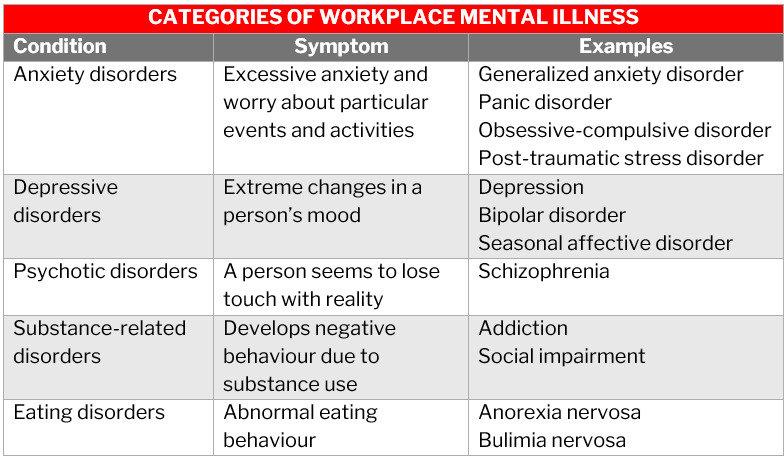Mental illness in the workplace can negatively impact both the employee and the business. Find out what the common disorders are and how to address them

Companies thrive when employees are healthy, motivated, and focused. But the reality is that no business is immune to mental health challenges. If left unchecked, mental illness in the workplace can have a negative impact on employee performance and engagement.
This is why taking a proactive stance on mental health issues isn’t just a matter of legal compliance and corporate responsibility for employers; it’s also a strategic move to boost workplace productivity and build employee trust and loyalty.
In this article, Benefits and Pensions Monitor delves deeper into the different types of mental illness in the workplace. We will also give you a rundown of the various treatment options available to employees. If you’re an employer seeking ways to address mental health issues in your company, you’ve come to the right place. Read on and find out how dealing with mental health challenges head-on can benefit your workplace in this guide.
Mental illness vs. mental health concern: what’s the difference?
In its workplace mental health guidebook, the Canadian Mental Health Association (CMHA) made a clear distinction between a mental illness and a mental health concern:
Mental illness
The national charity defines a mental illness as a “diagnosed disorder of thought, mood, or behaviour that has been present for an extended period of time (is not transient) and causes significant distress to the individual.”
Some examples of common mental health illnesses include:
- anxiety disorder such as generalized anxiety disorder
- major depressive disorder
- bipolar disorder
- schizophrenia
- eating disorders such as anorexia nervosa and bulimia nervosa
We will discuss the different categories of mental illness in the workplace in the succeeding section.
Mental health concern
A mental health concern is a “concern held by the individual due to a perceived deficit in mood or thought that is distressing but has not necessarily been present for an extended period.”
According to the CMHA, our mental health is influenced by several physical, social, and psychological factors, which contribute to its overall state. That’s why a person can have a mental illness but still be in excellent mental health. Conversely, a person may not have a mental illness but still be in poor mental state.
Learn more about practical mental health strategies for the workplace in this guide.
What are the common types of mental illness in the workplace?
The Saskatoon branch of the Species at Risk Committee (SARC) groups mental illness in the workplace into five categories:
1. Anxiety disorders
This type of mental illness is characterized by severe fear or anxiety associated with specific situations or objects. In the workplace, anxiety becomes a serious issue if the feelings of fear or tension are preventing the employee from doing their job. Some symptoms of anxiety disorder include:
- sense of fear or impending doom
- difficulty in concentrating
- excessive worrying
- irritability and restlessness
- rapid or slow thinking
- fatigue
- physical symptoms include shortness of breath, headache, nausea, dizziness, and chest pain
Anxiety disorders can be further categorized into:
- Generalized anxiety disorder: This is characterized by excessive anxiety and worry about particular events and activities, usually lasting for months.
- Panic disorder: This often starts with a sudden feeling of paralyzing terror or dread with symptoms that closely resemble those of a heart attack.
- Phobia: This condition is characterized by excessive fear of specific objects or situations. These include scenarios that can expose an employee to the possible judgment of others, also referred to as social phobia.
- Obsessive-compulsive disorder (OCD): This is marked by persistent distressing thoughts (obsessions) that a person tries to alleviate by doing repetitive intentional acts (compulsions).
- Trauma-related disorder: This occurs after a person is exposed directly or indirectly to terrifying or life-threatening situations. These include acts of violence, accidents, and natural disasters. A common example is post-traumatic stress disorder (PTSD).
2. Depressive disorders
This type of mental illness involves changes in a person’s mood. That’s why it is also called mood disorder. Some common signs of depressive disorder in the workplace are:
- overwhelming feelings of sadness or worthlessness
- withdrawal from others
- neglecting responsibilities
- lack of concern in physical appearance
- fatigue and decrease in energy
- changes in appetite
- difficulty in thinking or making decisions
Among the common examples of this type of mental illness in the workplace are:
- Major depression: This is characterized by extreme or prolonged feelings of sadness. An employee suffering from major depression loses interest in activities they previously enjoyed doing.
- Bipolar disorder: A person with this condition swings between episodes of extreme depression to intense mania or emotional highs. This type of mental illness is also called manic depressive disorder.
- Post-partum depression: This is a form of depression that can occur after the birth of a child, miscarriage, or abortion.
- Seasonal affective disorder (SAD): This is a type of depressive disorder that happens in the fall or winter. It may be related to shortened periods of daylight.
The CMHA doesn’t consider intermittent or situational stress as a mental illness. The organization, however, points out that stress is “certainly not conducive towards good mental health.”
3. Psychotic disorders
Also called psychosis, this condition occurs when a person seems to lose touch with reality. An employee with this type of mental illness may experience hallucinations, delusions, and disorganized thoughts and speech. Schizophrenia is one popular example of this condition.
4. Substance-related disorders
Substance-use, including drugs and alcohol, doesn’t necessarily mean that an employee has a substance-related disorder. However, this can lead to a mental health condition if a person develops negative patterns of behaviour for using the substance. This can adversely impact their job performance and workplace relationships.
Some behaviours associated with substance-related disorders include:
- addiction: inability to quit or limit use, often characterized by craving and consuming larger amounts
- social impairment: failing to meet obligations; substance use affects interpersonal relationships
- risky behaviour: involves actions that endanger themselves and others physically or psychologically
- pharmacological impact: requiring larger amounts to get the same effect; failure to satisfy this need may lead to withdrawal
The CMHA Ontario also warns that addiction is a Canada-wide problem. Data gathered by the organization has shown that more than a fifth of the country’s population will meet the criteria for addiction in their lifetimes.
The group also disproved the notion that a one-time user is likely to get hooked.
“Addictions are a product of the effect the drug or process has on the brain, a person’s lived experiences, mental health, and social factors,” the CMHA wrote in its guidebook.
5. Eating disorders
This type of mental illness is characterized by abnormal eating behaviours that adversely impact a person’s physical or mental health. Eating disorders often result from emotional difficulties as a coping mechanism. Some common examples of this condition are anorexia nervosa and bulimia nervosa.
Here’s a summary of the different categories of mental illness in the workplace:

How can employers deal with mental illness in the workplace?
Just like other types of illnesses, the best way to address mental illness in the workplace is by guiding the employee in getting the right treatment. These are the most common treatment options:
Physicians and other mental health professionals
The treatment process often starts by having the employee talk to a physician or other mental health specialists. It helps if workers can establish a connection with these professionals, so they can be open and honest about their thoughts and feelings.
Learn more about the different types of mental health workers in Canada in this guide.
Medication
Depending on their findings, mental health professionals can prescribe medication to employees to help relieve the symptoms of a mental illness. Medication, however, is most effective if taken alongside other forms of treatment and lifestyle changes. It may also cause side effects, that’s why careful monitoring by a mental health practitioner is important.
Psychotherapy
Psychotherapy is the most common form of mental health treatment. Depending on the need, employees may be required to attend short-term or long-term treatments. They may also be asked to participate individually, with partners or family members, or in a group setting.
Psychotherapy often involves the worker discussing their mental health struggles. Treatment can include finding ways to change one’s behaviour. It may also include counselling and cognitive behaviour therapy. Psychotherapy services are often accessible through an organization’s employee assistance program (EAP).
Specialist services
A mental health professional may also refer an employee suffering from mental illness in the workplace to specialist services. These include:
- Community mental health services: These usually consist of registered psychiatric nurses, community support workers, occupational therapists, and licensed clinical social workers. These professionals often receive input from psychologists and psychiatrists.
- Crisis resolution: This involves a home-based assessment and short-term treatment for employees in mental health crisis. It’s often done as an alternative to hospital admission.
- Early intervention: This is a specialist mental health service for staff who may be experiencing early signs of psychotic disorders.
- Drug and alcohol support services: This is a specialist service designed to help people with substance-related disorders.
- Hospital treatment: Some employees may require hospital treatment for their mental illness.
Supporting employees through mental illness is more than just a strategy to keep them on board. It demonstrates an organization’s commitment to its values, showing that the well-being of its staff is a priority.
When employees feel that their mental health concerns are recognized and addressed, they are more likely to remain engaged and return to peak performance. It also gives them an opportunity to contribute positively to the workplace culture. Building trust through these actions strengthens organizational integrity and fosters long-term commitment from all employees.
Learn more about the top employee mental health programs in Canada in this guide.
What are the benefits of a mentally healthy workplace?
Some employers may not realize how common mental health struggles are among their staff. Mental illness in the workplace is something that every business needs to address. This is not just for the well-being of a worker but also for the organization's overall success.
Here are some of the benefits of having a healthy, supportive, and positive work environment, according to Employment and Social Development Canada (ESDC):
- improves employee engagement
- boosts the morale of the workers
- enhances satisfaction among staff
- attracts and retains top talent
- increases productivity
- reduces absenteeism
- minimizes employee grievances
- decreases company’s health costs
- lessens the need for medical or disability leave
- prevents workplace injuries
Employees who are also supported through mental health challenges are more likely to return to full productivity sooner and stay loyal to the company.
How can you create a holistic mental health strategy for your company?
Check out our group benefits directory if you’re looking for specialists in health and wellness. Many of these companies offer holistic employee wellness programs, which includes collaborating with mental health workers.
By working with these companies and the mental health workers they partner with, your employees are guaranteed to get the best counselling and care.
Has your company dealt with mental illness in the workplace? How did it go? Let us know in the comments.



